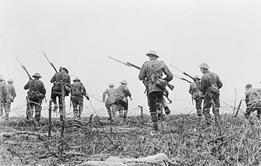To learn more about solicitors’ role in capital courts martial of the first world war, we need to discard some myths.
Alas for melodrama, no British soldier of the first world war was condemned to be 'shot at dawn'. The capital sentence passed on 3,080 occasions by field general courts martial between 1914 and 1920 was ‘to suffer death by shooting’. Of 346 executions actually carried out, most indeed took place at dawn: not for any symbolic or legal reason, according to one historian, former regular officer Gordon Corrigan, but 'because it was a quiet time – casual bystanders were not welcome'.
After researching this most emotive aspect of lawyers' involvement in the first world war in the run-up to the centenary, it has struck me how many widely accepted truths about these executions are simply wrong.
Among fallacies that need to be cleared up:
- The victims were shot for cowardice. In fact, two-thirds of those shot were convicted of desertion, objectively easier to prove. (The example in the 900-page 1914 Manual of Military Law is of a soldier who while on leave is found on a steamship with a ticket to New York.) The next largest category was murder, which of course carried the death penalty in civilian courts; over four years only 18 British soldiers were shot for showing cowardice and two for the archetypal military crime of sleeping on sentry.
- They were sentenced by kangaroo courts. By the rules and standards of their time, most field general courts martial seem to have been properly constituted, with three presiding officers and the accused not allowed to enter a guilty plea on a capital charge. True, the accused were not guaranteed legal representation, but they could pick any individual they liked as defending officer, who had to take the job unless there was good reason. Legally qualified officers were often available: one such was Captain Louis Crispin Warmington, a 40-year-old London solicitor serving in the Durham Light Infantry, who acted as prisoner's friend in at least three capital cases.
- Condemned men were shot the next morning, with no right of appeal. In fact, death sentences were reviewed at least four times up the chain of command, each stage having the power to 'mitigate, remit, commute or suspend'. Sentences could be modified only downward, and nine out of 10 death sentences were.
- The executed were mainly conscripts. Rather, the majority were either pre-war regulars or new army volunteers. Conscripts did not account for a major part of the army until mid-1917, when the peak of death sentences had already passed. (Statistics are from the authoritative study Blindfold and Alone, by Cathryn Corns and John Hughes-Wilson (Cassell, 2001)).
That said, there were undoubtedly miscarriages, as highlighted by the successful campaign for pardons, granted in 2006. Military justice is exemplary and recommendations for mercy were frequently ignored where a unit's discipline was judged to be bad and the victim judged of little use as a soldier. Officers and NCOs were judged more harshly than privates.
And, most notoriously, victims of post-traumatic stress - 'shell shock' – were shot after trials they were not mentally fit to stand.
After confirmation, a sentence was 'promulgated' to the unit and the victim, who was given 12 hours for prayers, letters or rum. One victim had a stay of 75 minutes because of 'thick fog at 4am'.
Court martial officers would not have been required to attend the final act, but probably some did. They would have seen a firing squad of 12 men paraded and ordered to load a single round. It seems to have been usual for the officer in charge to unload one or more rifles while the men's backs were turned. The condemned man was brought out blindfolded and tied to a chair or a post. One participant's account notes that the condemned man was the calmest one present.
To make life easier for presiding medical officers, a death certificate was pre-typed: the only detail that needed to be added was whether death was instantaneous or not. On one such document, dated 24 March 1917, the doctor has heavily underlined the word 'not'.
Afterwards, the squad was marched away to clean their rifles and, in all likelihood, to drown their shock. A fatigue party buried the victim along with other casualties: in this respect, execution seems to have wiped the slate clean.
Objectively, these 346 deaths are a tiny detail in the tragedies of millions. Campaigners against historic injustices could perhaps concentrate more on the hundreds of Belgian civilians summarily executed by the Germans for alleged resistance in 1914 alone, or the thousands of Serbs dealt with likewise by their Austrian allies.
However a century on, it is easy to understand why these dawn executions have such a hold. It was, after all, our army, and, down the decades, it is easier to put ourselves in the shoes of the condemned men rather than the generals. (My own brief civilian experiences of hostile fire leave me in little doubt that I would have quickly broken in the trenches.)
For the moment, I will go along with Corrigan's verdict: it was harsh justice, but it was generally justice, in a harsh war. But I would like to know what the lawyers participating in 238,000 wartime courts martial, as judge-advocates, court martial officers or prisoners' friends, made of the experience. If anyone has any contemporary memoirs, letters or research, please get in touch.
Michael Cross is Gazette news editor
First world war: record of service

To mark the centenary of the first world war, we look at the experiences of solicitors who served on all fronts. Some of these accounts were previously unpublished.
- 1
- 2
- 3
- 4
- 5
- 6
Currently reading
Shot at dawn: time to look at the truth



















1 Reader's comment